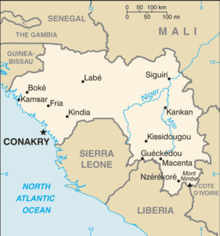1984 Guinean coup d'état
| 1984 Guinean coup d'état | |||||||
|---|---|---|---|---|---|---|---|
 Map of Guinea. | |||||||
| |||||||
| Belligerents | |||||||
| Commanders and leaders | |||||||
| Louis Lansana Beavogui | Lansana Conté | ||||||
| Casualties and losses | |||||||
| No casualties reported. | |||||||
Nexus of coup in Conakry (marked green), Guinea | |||||||
The 1984 Guinean coup d'état was the bloodless military coup that took place in Guinea on 3 April 1984, led by Colonel Lansana Conté.[1] It led to the deposition of Prime Minister Louis Lansana Beavogui, who had held the office since 1972, and had been serving as interim president since March, when longtime President Ahmed Sékou Touré died during an emergency heart operation at the Cleveland Clinic in the United States.[2][3]
The coup[edit]

The military struck just hours before the Politburo of the Democratic Party of Guinea (PDG), the only legally permitted party in the country, was to select a new leader. Interim president Beavogui was expected to win.[1] Under the Constitution, the PDG's leader would have been automatically elected to a seven-year term as president, and would have been confirmed in office via a referendum.
Colonel Conté suspended the constitution and dissolved the PDG, the National Assembly and all mass organizations. The Military Committee of National Restoration (CMNR) was created as the ruling junta.[1] He ordered the release of political prisoners held at Camp Boiro, a concentration camp within the capital Conakry.[4] Conté was named new President on 5 April.[5]
Aftermath[edit]
Eventually, a power struggle developed between Conté and a fellow member of the CMNR, Lieutenant Colonel Diarra Traoré (who briefly served as Prime Minister in April–December 1984), with the latter being executed in the aftermath of a failed coup attempt in July 1985.[6][7] Conté took advantage of the coup attempt to execute several of Ahmed Sekou Touré's close associates, including his half-brother Ismaël Touré (former chief prosecutor at Camp Boiro), Mamadi Keïta, Siaka Touré (former commander of Camp Boiro), Moussa Diakité,[8] and Abdoulaye Touré (former Minister of Foreign Affairs).[9]
Conté remained in power until his death on 22 December 2008,[10][11] which was almost immediately followed by another coup d'état, led by Captain Moussa Dadis Camara.[12][13]
See also[edit]
References[edit]
- ^ a b c "GUINEA'S MILITARY ASSUMES CONTROL; SEALS OFF NATION". The New York Times. 4 April 1984. Retrieved 26 October 2018.
- ^ "AHMED SEKOU TOURE, GUINEAN PRESIDENT, 62, DIES". The New York Times. 27 March 1984. Retrieved 26 October 2018.
- ^ Pace, Eric (March 28, 1984). "Ahmed Sekou Toure, a Radical Hero". The New York Times.
- ^ "IN POST-COUP GUINEA, A JAIL IS THROWN OPEN". The New York Times. 12 April 1984. Retrieved 26 October 2018.
- ^ "COLONEL IS NAMED GUINEAN PRESIDENT". The New York Times. 6 April 1984. Retrieved 26 October 2018.
- ^ "COUP ATTEMPT FOILED IN GUINEA; ARMY SEARCHES FOR REBEL LEADER". The New York Times. 6 July 1985. Retrieved 26 October 2018.
- ^ "LEADER OF GUINEA UPRISING TO BE SHOT, PRESIDENT SAYS". The New York Times. 8 July 1985. Retrieved 26 October 2018.
- ^ Lewin 2009, pp. 27.
- ^ Thomas O'Toole, Janice E. Baker (2005). "Toure, Al Jajj Abdoulaya". Historical dictionary of Guinea. Scarecrow Press. p. 195. ISBN 0-8108-4634-9.
- ^ "Guinea's long-time military leader Conte dies", AFP, 23 December 2008.
- ^ "Guinea's dictator, Lansana Conte, dies", Associated Press (International Herald Tribune), 23 December 2008.
- ^ "Military-led group announces coup in Guinea", Associated Press, 23 December 2008.
- ^ "Death of Guinea dictator prompts 'coup'", AFP (Sydney Morning Herald), 23 December 2008.
- Bibliography
- Lewin, André (2009). "20 à 30, le député français Sékou Touré conduit la Guinée à l'indépendance, et séduit en premier les pays communistes". Ahmed Sékou Touré, 1922–1924: président de la Guinée de 1958 à 1984. 1956–1958 (in French). Editions L'Harmattan. p. 27. ISBN 978-2-296-09528-1.


 French
French Deutsch
Deutsch